Avigo BICYCLE User Manual

the road to fun |

HELMETS
SAVE
LIVES!
ALWAYS WEAR A PROPERLY FITTED HELMET WHEN YOU RIDE YOUR BICYCLE. DO NOT RIDE AT NIGHT. AVOID RIDING IN WET CONDITIONS.
CORRECT FITTING
MAKE SURE YOUR HELMET COVERS YOUR FOREHEAD.
INCORRECT FITTING
FOREHEAD IS EXPOSED AND VULNERABLE TO SERIOUS INJURY.
i
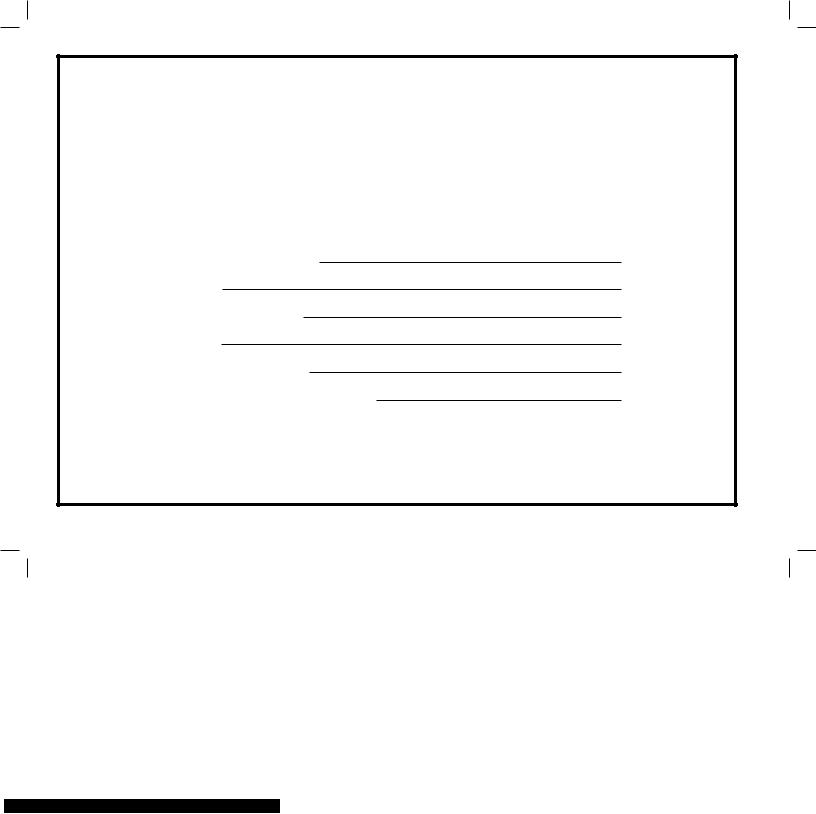
PLEASE RETAIN YOUR SALES RECEIPT AS PROOF OF PURCHASE. FILL OUT THE INFORMATION BELOW AND KEEP THIS MANUAL IN A SAFE PLACE.
BRAND/DESCRIPTION:
MODEL #:
PRODUCTION DATE:
SERIAL #:
DATE OF PURCHASE:
STORE/PLACE OF PURCHASE:
ii

ABOUT THIS MANUAL
This manual was writtento help you get the most performance, comfort, enjoyment and safety when riding your new bicycle. It is important for you to understand your new bike. By reading this manual before you go out on your first ride, you’ll know how to get the most from your new bicycle. It is also important that your first ride on your new bicycle is taken in a controlled environment, away from cars, obstacles, and other cyclists.
GENERAL WARNING
Bicycle ridingcan be a hazardous activity even under the best of circumstances. Proper maintenance of your bicycle is your responsibility as it helps reduce the risk of injury. This manual contains many “WARNINGS” and “CAUTIONS” concerning the consequences of failure to maintain or inspect your bicycle. Many of the warnings and cautions say,
“you may lose control and fall.” Because any fall can result in serious injury or even death, we do not repeat the warning of possible injury or death whenever the risk of falling is mentioned.
Dynacraft does not encourage stunting, trick riding, ramp riding, jumping, aggressive riding, riding on severe terrain, riding in severe climates, riding with heavy loads, riding double, commercial activities; such use is inherently dangerous, can cause serious injury to the rider, and if done it is with the rider’s express and implied assumption of the risk of such use and Dynacraft shall not have any responsibility for any breakdown of the bicycle, its components or rider injuries that occur during such use.
iii

A SPECIAL NOTE FOR PARENTS
It is a tragic fact that most bicycle accidents involve children. As a parent or guardian, you bear the responsibility for the activities and safety of your minor child. Among these responsibilities are to make sure that the bicycle which your child is riding is properly fitted to the child: that it is in good repair and safe operating condition; that the play of youngchil dren is supervised by an adult; that you and your child have learned, understand and obey not only the applicable local motor vehicle, bicycle and traffic laws, but also the common sense rules of safe and responsible bicycling. As a parent, you should read this manual before letting your child ride the bicycle. Please make sure that your child always wears an approved bicycle helmet when riding.
NOTE: The illustrations in this manual are used simply to provide examples; the components of your bicycle might differ. In addition, some of the parts shown might be optional and not part of the bicycle’s standard equipment.
iv
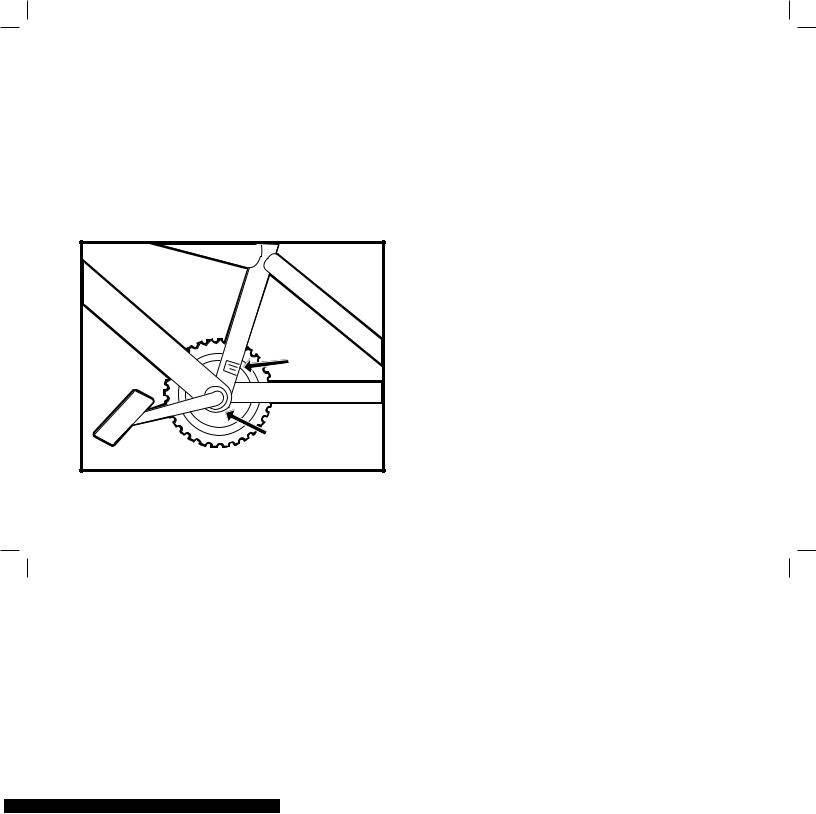
The following manual is only a guide to assist you and is not a complete or comprehensive manual of all aspects of maintaining and repairing your bicycle. The bicycle you have purchased is a complex object. We recommend that you consult a bicycle specialist if you have doubts or concerns as to your experience or ability to properly assemble, repair, or maintain your bicycle. You will save time and the convenience of having to go back to the store if you choose to write or call us concerning missing parts, service questions, operating advice, and/or assembly questions.
Model Number & |
Production Date |
Serial Number |
DYNACRAFT CUSTOMER SERVICE 1.800.551.0032
7AM to 4PM PACIFIC TIME
Dynacraft BSC, Inc.
89 South Kelly Road, American Canyon, CA 94503 www.dynacraftbikes.com
v

DIRECTORY
vi | DIRECTORY
INDEX |
|
|
|
|
|
|
|
vii |
|
|
|
|
|
|
|
|
|
|
|
TOOLS |
|
|
|
|
|
|
|
1 |
|
|
|
|
|
|
|
|
|
|
2-5 |
PARTS LIST/IDENTIFICATION |
|
||||||||
|
|
|
|
|
|
|
|
|
|
BEFORE YOU RIDE |
|
|
|
6-25 |
|||||
|
|
|
|
|
|
|
|
|
|
ASSEMBLY |
|
|
|
26-64 |
|||||
|
|
|
|
|
|
|
|
|
|
HOW THINGS WORK |
|
|
65-75 |
||||||
|
|
|
|
|
|
|
|
|
|
SERVICING |
|
|
76-78 |
||||||
|
|
|
|
|
|
|
|
|
|
DETAILED MAINTENANCE |
|
79-107 |
|||||||
|
|
|
|
|
|
|
|
|
|
TROUBLE SHOOTING |
|
108-110 |
|||||||
|
|
|
|
|
|
|
|
|
|
REGISTRATION CARD AND WARRANTY |
111-116 |
||||||||
|
|
|
|
|
|
|
|
|
|
WARNING/IMPORTANT |
DYNACRAFT BSC, INC. |
Take notice of this symbol throughout this manual |
89 South Kelly Road, American Canyon, CA |
and pay particular attention to the instructions |
94503 Customer Service 1.800.551.0032 |
blocked off and preceded by this symbol. |
www.dynacraftbikes.com |

TOOLS
PARTS LIST/
IDENTIFICATION
Mountain Bicycles
Dual Suspension Bicycles
BMX Bicycles
Road Bicycles
BEFORE YOU RIDE
Standover Height
Frame Weight Limit
Correct Frame Size
Rules of the Road
Off Road/Rider Safety
Riding Position
Saddle Height
Reach
Handlebar Height
SAFETY CHECKLIST
Brakes
Wheels & Tires
Steering
Cranks & Pedals
Chain
Bearings
Derailleurs
Frame & Fork
Accessories
Helmets
Reflectors
GEARS - HOW TO
OPERATE
Derailleur Gears
Operating Principles
Hand Grip Shifters
Thumb Shifters
1 Below the Bar Shifters
BICYCLE CARE
Basic Maintenance
2 Storage
3 Security
45 ASSEMBLYDERAILLEUR GEARED
BIKES
6 Handlebars
6 Forks
7 Seat and Seat Post
8 Max./Min. Insertion Mark
1014 Pedals and Crank Set
14 BRAKES
14 Cantilever with Link Wire
15 V-Style
Check your Brakes 16 Disk Brakes
16 DERAILLEUR
16 Rear Derailleur
16 Front Derailleur
17 Dual Suspension
17 Rear Pivots
17 Accessories
17 Reflectors
17 Front Fender Assembly
18 Basket Assembly
18 Rear Rack Assembly
Final Check
SINGLE SPEED & BMX
21FrontwheelHandlebars
22Seat
23Pedals and Crank Set21
23Hand Brake Side Pull Brake
24Cantilever U-Brake
25Check your Brakes
25Training Wheels Rotors
Final Check
26HOW THINGS WORK
27Removing Bolt on Wheels
30Seatpost Quick Release
31Brakes
32Shifting
34Tires and Tubes Bicycle Suspension
35 SERVICING
37 Schedule 1 - Lubrication
40 Schedule 2 - Service
41 Checklist
DETAILED
42 MAINTENANCE
43 Wheel Inspection
44 Tire Inspection
45 Tire Pressures
46 Hub Bearing Adjustment
46 Flat Tire Repair
47 Handlebar Stem
49 Handlebars
50 Grip Shift Installation
51Cables and Cable
52HousingHEADSET52
53 Inspection
54 Adjustment
55
56 |
SADDLE & SEAT POST |
|
|
|
INDEX |
||
56 |
Inspection |
88 |
|
57 |
Lubrication |
88 |
|
59 |
Saddle Adjustment |
89 |
|
60 |
Adjustment Sidepull |
|
|
60 |
Calipers |
91 |
|
60 |
Adjustment Cantilever |
|
|
64 |
Calipers |
92 |
|
66 |
DRIVETRAIN |
|
|
Pedals |
94 |
|
|
67 |
-Inspection |
94 |
|
68 |
-Lubrication and |
|
|
69 |
Adjustment |
95 |
|
73 |
-Attachment |
95 |
|
75 |
Crankset |
96 |
|
|
-Adjustment |
98 |
|
76 |
Binder Crank |
|
|
|
Replacement/Removal |
100 |
|
78 |
-Chain |
101 |
|
|
-Inspection |
101 |
|
|
-Lubrication |
101 |
|
79 |
-Adjustment and |
|
|
Replacement |
101 |
|
|
80 |
-Freewheel/Inspection |
102 |
|
80 |
-Lubrication |
103 |
|
81 |
-Coaster Hub |
103 |
|
81 |
DERAILLEUR SYSTEMS |
|
|
83 |
Inspection |
104 |
|
84 |
|
||
85 |
Adjustment (front) |
105 |
|
|
Lubrication |
106 |
|
86 |
Adjustment (rear) |
106 |
|
|
Reflectors |
107 |
|
87 |
TROUBLESHOOTING |
108 |
|
87 |
REGISTRATION CARD |
|
|
|
& WARRANTY |
111 |
|
INDEX |
| vii |

TOOLS
TOOLS REQUIRED
1.Allen key wrenches: 4 mm, 5 mm, 6 mm, 8 mm
2.Adjustable wrench
3.Tire lever
4. |
Standard Phillips head screwdriver |
1 |
2 |
3 |
4 |
|
|
|
|
||
5. |
Open end or pedal wrench 15 mm |
|
|
|
|
6. |
Standard slip joint pliers |
|
|
|
|
7. |
Tire pump |
|
|
|
|
8. |
Standard flat head screwdriver |
|
|
|
|
|
|
5 |
6 |
7 |
8 |
TRAVEL TOOLS
1. |
Spare Tube |
1 |
2 |
3 |
4 |
2. |
Patch Kit |
|
|
|
|
3. |
Pump |
|
|
|
|
4. |
Tire Levers |
|
|
|
|
5. |
Multi-tool |
|
|
|
|
6. |
Change (phone call) |
5 |
5 |
6 |
|
1 | TOOLS

MOUNTAIN BICYCLES
Mountain bicycles are designed to give maximum comfort over a wide variety of road surfaces. The wider handlebars and convenient shift lever position make them very easy to control. Wider rims and tires give them a softer ride with more traction on rough surfaces. The frame and fork on mountain bicycles are much sturdier than those on racing style bicycles.
|
|
Shift Lever |
|
|
|
Brake Lever |
|
|
|
Handlebar |
|
|
Handlebar Stem |
|
|
Seat |
Head Set |
Front Reflector |
|
Head Tube |
|
||
Seatpost |
|
||
Top Tube |
Brake Control Cable |
||
Rear Reflector |
|||
|
Gear ControlCable |
||
Quick Release |
|
||
|
Front Reflector |
||
|
|
||
|
Gear Control Cable |
|
|
|
Down Tube |
Front Brake |
|
|
Seat Tube |
||
|
Front Fork |
||
|
|
||
Rear Brake |
Front Derailleur |
Wheel Reflector |
|
Seat Stay |
Front Hub |
||
Freewheel |
Bottom Bracket |
Spokes |
|
Axle |
|
||
Wheel Reflector |
|
||
Chain Wheel |
|
||
Rear Derailleur |
|
||
Crank Arm |
|
||
|
|
||
|
Pedal |
|
|
|
Chain Guard |
Tire |
|
|
|
||
|
|
Rim |
|
|
Chain Stay |
Retaining Washer |
|
|
Chain |
Tire Valve |
IDENTIFICATION / LIST PARTS
PARTS LIST / IDENTIFICATION | 2

PARTS LIST / IDENTIFICATION
DUAL SUSPENSION MOUNTAIN BICYCLES
Dual Suspension Mountain bicycles are designed to give maximum comfort over a wide variety of road surfaces.
|
|
Shift Lever |
|
|
|
Brake Lever |
|
|
Handlebar Stem |
|
|
|
Head Set |
|
|
Seat |
Head Tube |
Handlebar |
|
Quick Release |
Top Tube |
Front Reflector |
|
Rear Reflector |
Down Tube |
Gear Control Cable |
|
Seatpost |
|
Brake Control Cable |
|
Pivot (behind chain wheel) |
|
|
|
Rear Brake |
|
|
|
Seat Stay |
|
Front Brake |
|
Freewheel |
|
||
|
Front Fork |
||
Wheel Reflector |
Front Derailleur |
||
Wheel Reflector |
|||
|
Bottom Bracket |
||
|
|
||
|
Axle |
Front Hub |
|
|
Chain Wheel |
Spokes |
|
|
Crank Arm |
|
|
|
Pedal |
|
|
|
Chain Guard |
|
|
|
|
Tire |
|
|
|
Rim |
|
|
Chain Stay |
Retaining Washer |
|
|
|
||
|
Chain |
Tire Valve |
|
|
Rear Derailleur |
|
3 | PARTS LIST / IDENTIFICATION
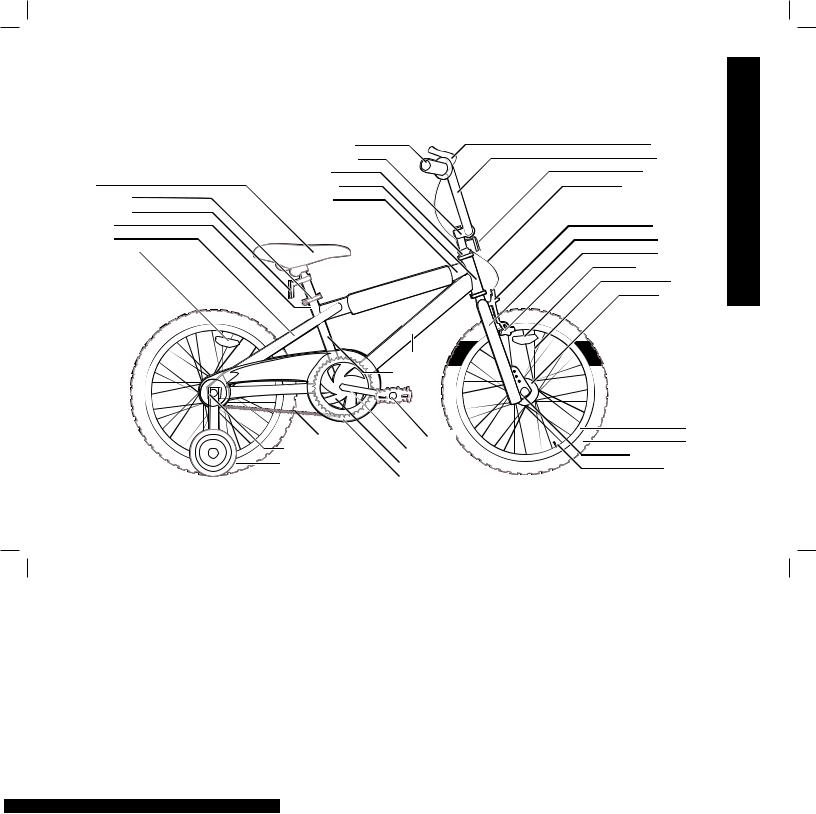
BMX BICYCLES
BMX bicycles are a popular general purpose type most suited for young riders. They are valued because of their sturdy and simple construction, and low maintenance.
|
Handlebar Grip |
Brake Lever |
|
Handlebar Stem |
Handlebar |
|
Head Set |
Front Reflector |
Seat |
Head Tube |
Brake Control Cable |
Quick Release |
Tube |
|
Rear Reflector |
|
|
Seatpost |
|
Front Brake |
Seat Stay |
|
Front Fork |
Wheel |
|
Brake Pad |
|
|
Wheel Reflector |
|
|
Spokes |
|
|
Front Hub |
Chain |
Rear Sprocket |
Training Wheels |
(16” and smaller)
Down Tube 
Seat Tube
Pedal |
Rim |
|
Tire |
||
Crank Arm |
||
Retaining Washer |
||
Chain Wheel |
||
Tire Valve |
||
Chain Guard |
||
|
IDENTIFICATION / LIST PARTS
PARTS LIST / IDENTIFICATION | 4
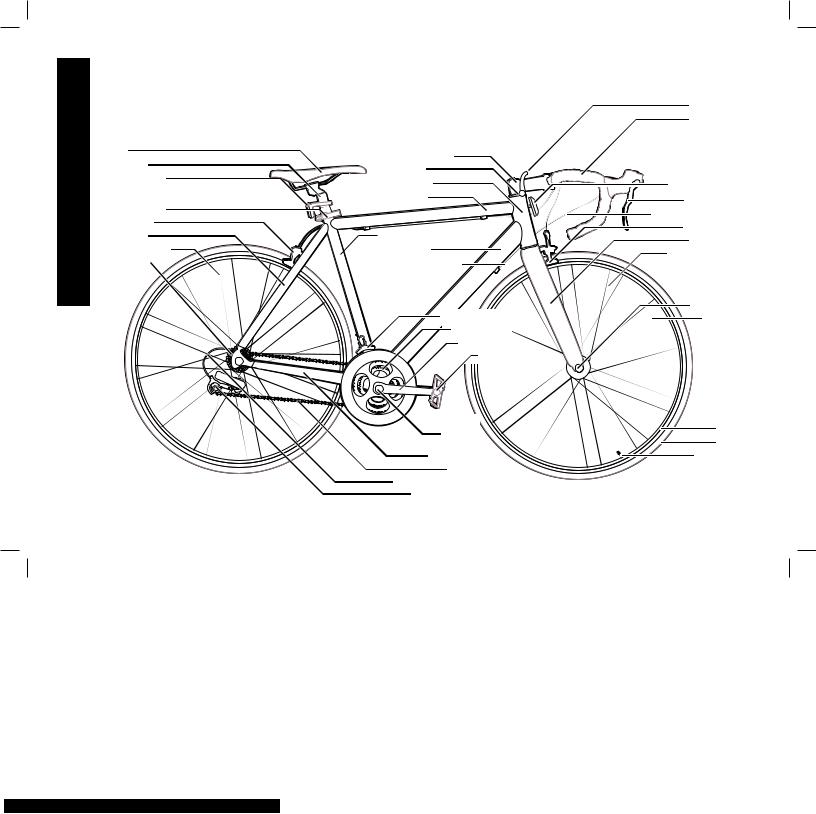
PARTS LIST / IDENTIFICATION
ROAD BICYCLES
Road bicycles are designed for fast travel, hard training and competition on paved surfaces exclusively. It is the lightest, most aerodynamic and “fastest” type of bicycle.
Seat |
Handlebar Stem |
|
Seatpost |
||
Head Set |
||
Rear Reflector |
||
Head Tube |
||
|
||
|
Top Tube |
|
Quick Release |
|
|
Rear Brake |
|
|
Seat Stay |
Seat Tube |
|
Wheel Reflector |
Down Tube |
|
Freewheel |
Gear Control Cable |
Front Derailleur
Chain Wheel
Crank Arm
Pedal
 Chain Guard
Chain Guard
Bottom
Bracket Axle
Chain Stay
Chain
Gear Control Cable
Rear Derailleur
Shift Lever
Handlebar
Front Reflector
Brake Lever
Brake Control Cable
Front Brake
Front Fork
Wheel Reflector
Front Hub
Spokes
Rim
Tire
Tire Valve
5 | PARTS LIST / IDENTIFICATION
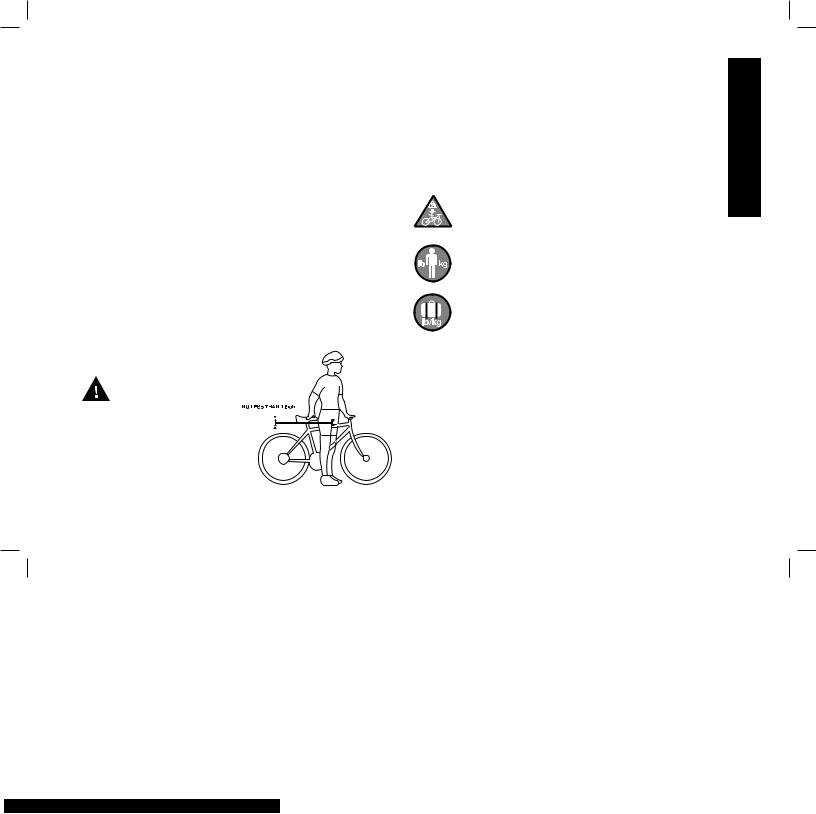
STANDOVER HEIGHT
1. Diamond Frame Bicycles
Standover height is the basic element of bike fit (see figure). It is the distance from the ground to the top tube of the bicycle’s frame at that point where the top of the inseam of your pants is when straddling the bike. To check for correct standover height, straddle the bike while wearing the kind of shoes in which you’ll be riding, and bounce vigorously on your heels. If the inseam touches the frame, the bike is too big for you. Don’t even ride the bike around the block. A bike which
you ride only on paved surfaces and never take off-road should give you a minimum standover height clearance of one inch (2.6 cm). A bike that you’ll ride on unpaved surfaces should give you a minimum of three inches (7.5 cm) of standover height clearance.
2. Step-Through Frame Bicycles
Standover height does not apply to bicycles with step-through frames. Instead, the limiting dimension is determined by comparing a diamond frame bike that properly fits and then selecting the step-through bike of the same size.
WARNING
If your bicycle does not fit properly, you may lose control and fall. If your new bike doesn’t fit, ask your dealer to exchange it before you ride.
FRAME WEIGHT LIMIT
There is no American standard for testing the structural weight limits of bicycle frames and for each bike type our limits were determined through lab testing using international standards that seemed reasonable. Not all models were tested. Limits are based on the test results for exemplars of a 20 inch free style bicycle, a 26 inch diamond frame bicycle and a 26 inch dual suspension frame bicycle.
Structural Weight Limit:The maximum weight (rider and cargo) a bike frame can physically support.
Rider Weight:The weight of the rider in riding gear (e.g., jacket, helmet cam, hydration pack, helmet, etc.).
CARGO WEIGHT:The weight of any additional accessories (e.g., panniers, rear racks, saddle bags, handlebar bags, baskets, etc.) not accounted for in Rider Weight.
WEIGHT LIMIT:The maximum structural weight recommendations for our bicycles that are 20 inches or larger are:
·Free Style 20 inch bicycles:176 lbs. (80 kg.).
·Diamond frame adult
bicycles up to 26 inches: 275 lbs. (125 kg.).
· Dual suspension frame adult
bicycles up to 26 inches: 275 lbs. (125 kg.).
RIDE YOU BEFORE
BEFORE YOU RIDE | 6

BEFORE YOU RIDE
CORRECT FRAME SIZE
When selecting a new bicycle, the correct choice of frame size is a very important safety consideration.
CAUTION
For safe and comfortable riding there should be a clearance of no less than 1 inch between the inseam area of the intended rider and the top tube of the bicycle frame, while the rider straddles the bicycle with both feet flat on the ground.
WARNING
If the bicycle is too large the rider cannot reach the pedals easily, or the ground when stopping which may result in loss of control and/or injury.
SAFE SIZING FOR JUVENILE AND SIDEWALK BICYCLES
It is assumed that the bicycle youaveh bought is sized correctly for the user. Some parents make the mistake of buying a bicycle too large for the intended rider, planning on the child “growing into” it. There should be a minimum of 1 inch clearance above the highest point of the top tube when the child is straddling the bicycle with both feet on the ground (see drawing below).
7 | BEFORE YOU RIDE

RULES OF THE ROAD AND SAFETY TIPS
NOTE: Like any sport, bicycling involves risk of injury and damage. By choosing to ride a bicycle, you assume the responsibility for that risk; not the people who sold you the bike; nor the people who made it; nor the people who distribute it; nor the people who manage or maintain the roads and trails you ride on. YOU. So you need to know - and to practice - the rules of safe and responsible riding.
1.IN THE INTEREST OF SAFER CYCLING, MAKE SURE YOU READ AND UNDERSTAND YOUR OWNER’S MANUAL. NOTE AND PERFORM PRE RIDE SAFETY CHECKS.
2.NOTICE: Some state and local laws may require that your bicycle be equipped with a warning device such as a horn or bell and a light if the bicycle is to be ridden after dark.
3.ALWAYS WEAR SHOES when riding a bicycle and
AVOID LOOSE FITTING CLOTHES.
4.CHECK YOUR BRAKES FREQUENTLY. THE ABILITY TO STOP YOUR BICYCLE IS CRITICAL.
Roads are slippery when wet so avoid sharp turns and allow more distance stopping. Caliper brakes may become less efficient when wet. Leaves, loose gravel, and other debris can also effect stopping.
5.ALWAYS RIDE IN THE SAME DIRECTION AS TRAFFIC. Never ride against traffic.
6. STOP AND LOOK BEFORE YOU LEAVE AN ALLEY, DRIVEWAY, OR PARKING LOT. Stop, look to the left, to the right, and to the left again for traffic. Ride only when it is clear.
7.KEEP TO THE RIGHT. Follow the traffic flow in a straight line and stay close to the curb. Watch for cars moving in and out of traffic.
8.OBEY ALL TRAFFIC LAWS REGULATIONS. Most traffic regulations apply to bike riders as well as automobile operators.
9.ALWAYS RIDE ALONE. NEVER CARRY OTHER RIDERS. This is dangerous and makes the bike harder to control. The bicycles distributed by Dynacraft BSC, Inc. are intended for one rider only.
10.ALWAYS BE ALERT. Be ALERT - pedestrians have the right of way. Be ALERT - when riding near parked cars - ride far enough away from the cars so that you won’t get hit if someone opens the car door.
LEFT |
STOP |
RIGHT |
RIDE YOU BEFORE
BEFORE YOU RIDE | 8

BEFORE YOU RIDE
RULES OF THE ROAD AND SAFETY TIPS (continued)
11.USE CAUTION AT ALL INTERSECTIONS AND STOP SIGNS. STOP AND LOOK BOTH WAYS BEFORE PROCEEDING.
12.USE HAND SIGNALS. Communicate by using hand signals to tell other drivers what you are going to do. Signal 100 feet before turning unless your hand is needed to control the bike (see page 8 for hand signal instructions).
13.HAVE PROPER LIGHTS AND REFLECTORS. IF YOU RIDE AT NIGHT, be sure to have a strong head-
light, a tail light, and a full set of reflectors. CHECK THAT REFLECTORS ARE CLEAN, STRAIGHT, UNBROKEN, AND SECURELY MOUNTED.
14.NEVER CARRY PACKAGES OR OBJECTS WHICH OBSTRUCT VISION.
15.NEVER HITCH RIDES, never hold onto a moving vehicle while riding.
16.THE KICKSTAND IS DESIGNED TO SUPPORT
THE BICYCLE ONLY, not the bicycle and the rider.
17.AVOID THE FOLLOWING HAZARDS: Drain grates, potholes, soft road edges, gravel, sand, wet leaves, and/or any obstruction in the road. Failure to do so could cause wheel(s) to buckle and result in personal injury to the rider.
18.WET WEATHER RIDING -Riding your bicycle in wet conditions is not recommended. In wet conditions traction and braking power is reduced. Riding in such conditions could result in personal injury.
19.PROPER HELMET USE. A helmet that meets
the CPSC (Consumer Product Safety Commission) standard should always be worn when riding a bicycle. The helmet should fit properly and worn on the crown of the head, not tipped back.
20.USE BIKE LANESwhen available. Also note that in certain states, cars may use bike lanes when turning.
21.Respect “Bicycles Are Prohibited” signs.
9 | BEFORE YOU RIDE

OFF ROAD SAFETY
We recommend that children not ride on rough terrain unless they are accompanied by an adult. Off road riding on approved trails with appropriate protective equipment can be done with mountain bikes and BMX bikes if you have the skill and experience necessary to maintain control. Whether you call it Aggro, Hucking, Freeride, North Shore, Downhill, Jumping, Stunt Riding, Racingor something else: it isNOT off road riding, it isNOT recommended and if you engage in this sort of extreme, aggressive riding you will get hurt , and you voluntarily assume a greatly increased risk of injury or death. Dynacraft bicycles are not designed for these types of extreme riding.
WARNING
Although many catalogs, advertisements and articles about bicycling depict riders engaged in extreme riding, this activity is extremely dangerous, increases your risk of injury or death, and increases the severity of any injury. Remember that the action depicted is being performed by professionals with many years of training and experience. Even with state-of-the-art protective safety gear, you could be seriously injured or killed when jumping, stunt riding,
riding downhill at speed or in competition.
WARNING
Bicycles and bicycle parts have limitations with regard to strength and integrity, and this type of riding can exceed those limitations.
The variable conditions and hazards of off-road riding require close attention and specific skills. Start slowly on easier terrain and build up your skills. If your bike has suspension, the increased speed you may develop also increases your risk of losing control and falling. Get to know how to handle your bike safely before trying in-
creased speed or more difficult terrain.
1.Wear safety gear appropriate to the kind of riding you plan to do.
2.Don’t Ride alone in remote areas. Even when riding with others, make sure that someone knows where you’re going and when you expect to be back.
3.Always take along some kind of identification, so that people know who you are in case of an accident; and take along some cash for food, a cool drink or an emergency phone call.
RIDE YOU BEFORE
BEFORE YOU RIDE | 10

BEFORE YOU RIDE
(continued)
4.Yield right of way to pedestrians and animals. Ride in a way that does not frighten or endanger them, and give them enough room so that their unexpected moves don’t endanger you.
5.Be prepared. If something goes wrong while riding off-road, help may not be close.
6.Do NOT attempt to jump, do stunt riding or race with your bike.
OFF ROAD RESPECT
Obey thelocal laws regulating where and how you can ride off-road, and respect private property. You may be sharing the trail with others — hikers, equestrians, other cyclists. Respect their rights. Stay on the designated trail. Don’t contribute to erosion by riding in mud or with unnecessary sliding. Don’t disturb the ecosystem by cutting your own trail or shortcut through vegetation or streams. It is your responsibility to minimize your impact on the environment. Leave things as you found them; and always take out everything you brought in.
WET WEATHER RIDING
Under wet conditions, the stopping power of your brakes (as well as the brakes of other vehicles sharing the road) is dramatically reduced and your tires don’t grip nearly as well. This makes it harder to control speed and easier to lose control. Dynacraft does not recommend that you ride under these conditions.
WARNING
Wet weather impairs traction, braking and visibility, both for the bicyclist and for other vehicles sharing the road. The risk of an accident is dramatically increased in wet conditions.
11 | BEFORE YOU RIDE
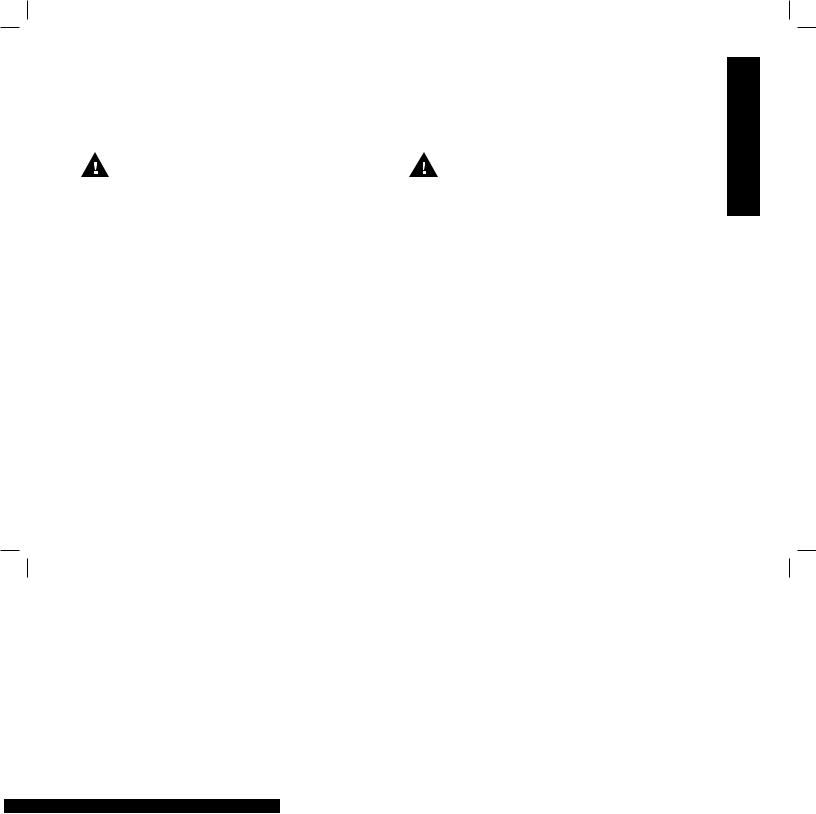
NIGHT RIDING
Riding a bicycle at nightis much more dangerous than riding during the day. A bicyclist is very difficult for motorists and pedestrians to see. Therefore, children should never ride at dawn, at dusk or at night. Adults who choose to accept the greatly increased risk of riding at dawn, at dusk or at night need to take extra care both riding and choosing specialized equipment which helps reduce that risk. Consult your dealer about night riding safety equipment.
WARNING
Reflectors are not a substitute for required lights. Riding at dawn, at dusk, at night or at other times of poor visibility without an adequate bicycle lighting system and without reflectors is dangerous and may result in serious injury or death.
WARNING
Do not remove the front or rear reflectors or reflector brackets from your bicycle. They are an integral part of the bicycle’s safety system. Removing the reflectors reduces your visibility to others using the roadway. Being struck by other vehicles may result in serious injury or death.
PEDALING TECHNIQUE
•Position the ball of your foot on the corner of the pedal.
•When pedaling, ensure your knees are parallel to the bike frame.
•To absorb shock, keep your elbows slightly bent.
•Learn to operate the gears properly (refer to pages 21-23).
HILL TECHNIQUE
•Gear down before a climb and continue gearing down as required to maintain pedaling speed.
•If you reach the lowest gear and are struggling, stand up on your pedals. You will then obtain
more power from each pedal revolution.
•On the descent, use the high gears to avoid rapid pedaling.
•Do not exceed a comfortable speed, maintain control and take additional care.
RIDE YOU BEFORE
BEFORE YOU RIDE | 12

BEFORE YOU RIDE
CORNERING TECHNIQUE
Brake slightlybefore cornering and prepare to lean your body into the corner. Maintain the inside pedal at the 12 o’clock position and slightly point the inside knee in the direction you are turning. Keep the other leg straight, don’t pedal through fast or tight corners.
RULES FOR CHILDREN
To avoid an accident, teach children good ridingkills with an emphasis on safety from an early age.
1.Always wear a properly fitted helmet.
2.Do not play in driveways or the road.
3.Do not ride on busy streets.
4.Do not ride at night.
5.Obey all traffic laws, especially stop signs and red lights.
6.Be aware of other road vehicles behind and nearby.
7.Before entering a street: Stop, look left, right, and left again for traffic.
8.If riding downhill, be extra careful. Slow down using the brakes and maintain control of steering.
9.Never take your hands off the handlebars, or your feet off the pedals when riding downhill.
CAUTION
The Consumer Product Safety Commission advises that the riding of small wheel diameter bicycles at excessive speeds can lead to instability and is not recommended.
Children should be made aware of all possible riding hazards and correct riding behavior before they take to the streets.
DO NOT LEAVE IT UP TO TRIAL AND ERROR.
13 | BEFORE YOU RIDE
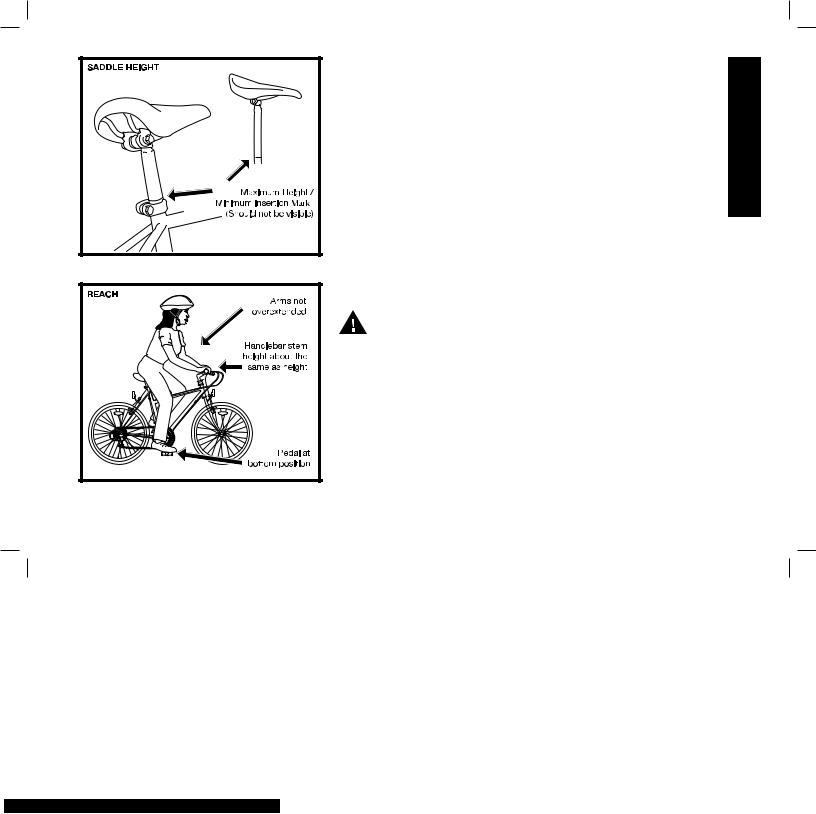
RIDING POSITION
Saddle Height
In order to obtain the most comfortable riding position and offer the best possible pedaling efficiency, the seat height should be set correctly in relation to the rider’s leg length. The correct saddle height should not allow leg strain from over-extension, and the hips should not rock from side to side when pedaling. While sitting on the bicycle with one pedal at it’s lowest point, place the ball of your foot on that pedal. The correct saddle height will allow the knees to be slightly bent in this position. If the rider then places the heel of that foot on the pedal, the leg should be almost straight.
Reach
To obtain maximum comfort, the rider should not overextend his or her reach when riding. To adjust the distance, the position of the seat can be altered in relation to the seat pillar.
CAUTION
Under no circumstances should the seatpost project from the frame beyond its “Minimum Insertion” or “Maximum Extension” mark. If your seatpost projects from the frame beyond these markings, the seatpost or frame may break, which could cause you to lose control and fall. After any saddle adjustment, be sure to tighten the saddle adjusting mechanism properly before riding. A loose saddle clamp or seatpost binder can cause damage to the bicycle or can cause you to loose control and fall. Periodically check to make sure that the saddle adjusting mechanism is properly tightened.
RIDE YOU BEFORE
BEFORE YOU RIDE | 14

BEFORE YOU RIDE
HANDLEBAR HEIGHT
Maximum comfort is usually obtained when the handlebar height is equal to the height of the seat. You may wish to try different heights to find the most comfortable position.
WARNING
Over tightening the stem bolt or headset assembly may cause damage to the bicycle and/or injury to the rider.
WARNING
The stem’s “Minimum Insertion” mark must not be visible above the top of the headset. If the stem is extended beyond this mark, the stem may break or damage the fork’s steerer tube, which could cause you to lose control and fall.
CAUTION
Failure to properly tighten the stem wedge bolt, the handlebar binder bolt, or the bar end extension clamping bolts may compromise steering action, which could cause you to lose control and fall. Place the front wheel of the bicycle between your legs and attempt to twist the handlebar/stem assembly. If you can twist the stem in relation to the front wheel, turn the bar end extensions in relation to the handlebar, you must tighten the appropriate bolts accordingly.
15 | BEFORE YOU RIDE
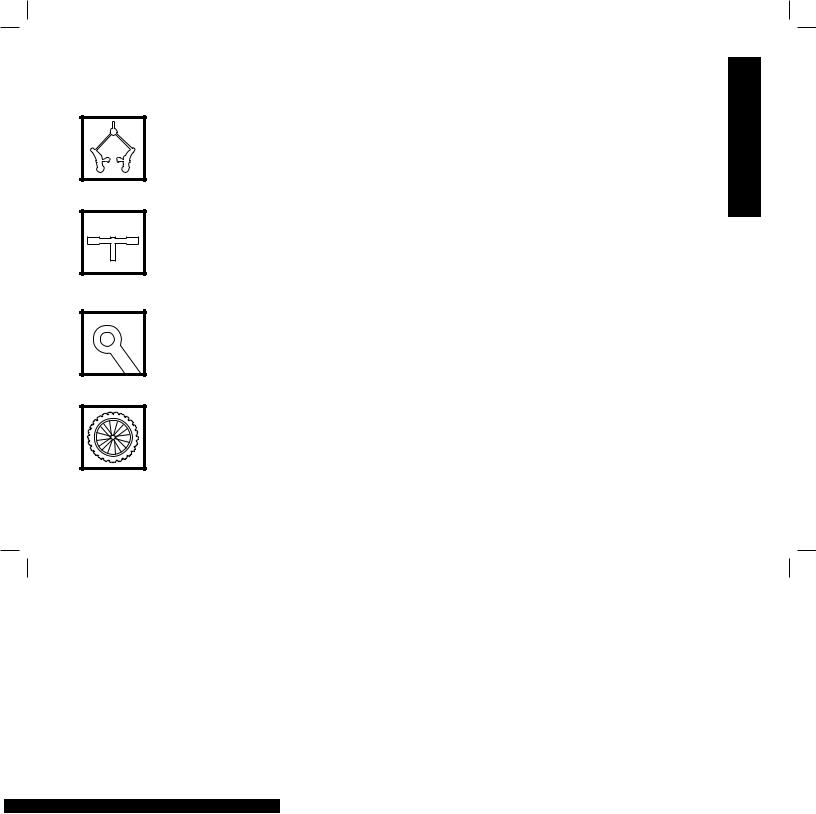
SAFETY CHECKLIST
Before every ride, it is important to carry out the following safety checks: (For information and instructions on performing specific equipment checks, locate the relevant section in the manual using the index on page vii).
1. Brakes
• Ensure frontand rear brakes work properly.
• Ensure brake shoe pads are not over worn and are correctly positioned in relation to the rims.
• Ensure brake control cables are lubricated, correctly adjusted, and display no obvious wear.
• Ensure brake control levers are lubricated and tightly secured to the handlebar.
2. Steering
•Ensure handlebar and stem are correctly adjusted and tightened, and allow proper steering.
•Ensure that the handlebars are set correctly in relation to the forks and the direction of travel.
•Check that the head set locking mechanism is properly adjusted and tightened.
•If the bicycle is fitted with handlebar end extensions, ensure they are properly positioned
and tightened.
3. Cranks and Pedals
•Ensure pedals are securely tightened to the cranks.
•Ensure cranks are securely tightened to the axle and are not bent.
4. Wheels and Tires
• Ensure tires are inflated to within the maximum recommended limit as displayed on the tire sidewall.
•Ensure tires have tread and have no bulges or excessive wear.
•Ensure rims run true and have no obvious wobbles or kinks.
•Ensure all wheel spokes are tight and not broken.
•Check that axle nuts are tight.
RIDE YOU BEFORE
BEFORE YOU RIDE | 16

BEFORE YOU RIDE
17 | BEFORE YOU RIDE
5. Chain
•Ensure chain is oiled, clean and runs smoothly.
•Extra care is required in wet or dusty conditions.
•On bicycles equipped with coaster brakes, check for proper chain tension.
6. Derailleurs
•Check hat front and rear mechanisms are adjusted and function properly.
•Ensure control levers are securely attached.
•Ensure derailleurs, shift levers and control cables are properly lubricated.
7. Bearings
• Ensure all bearings are lubricated, run freely and display no excess movement, grinding or rattling.
• Check headset, wheel bearings, pedal bearings and bottom bracket bearings.
8. Frame and Fork
• Check hat the frame and fork are not bent or broken.
• If either are bent or broken, they should be replaced.
9. Accessories
•Ensure that all reflectors are properly fitted and not obscured.
•Ensure all other fittings on the bike are properly and securely fastened, and functioning.
•Ensure the rider is wearing a helmet.
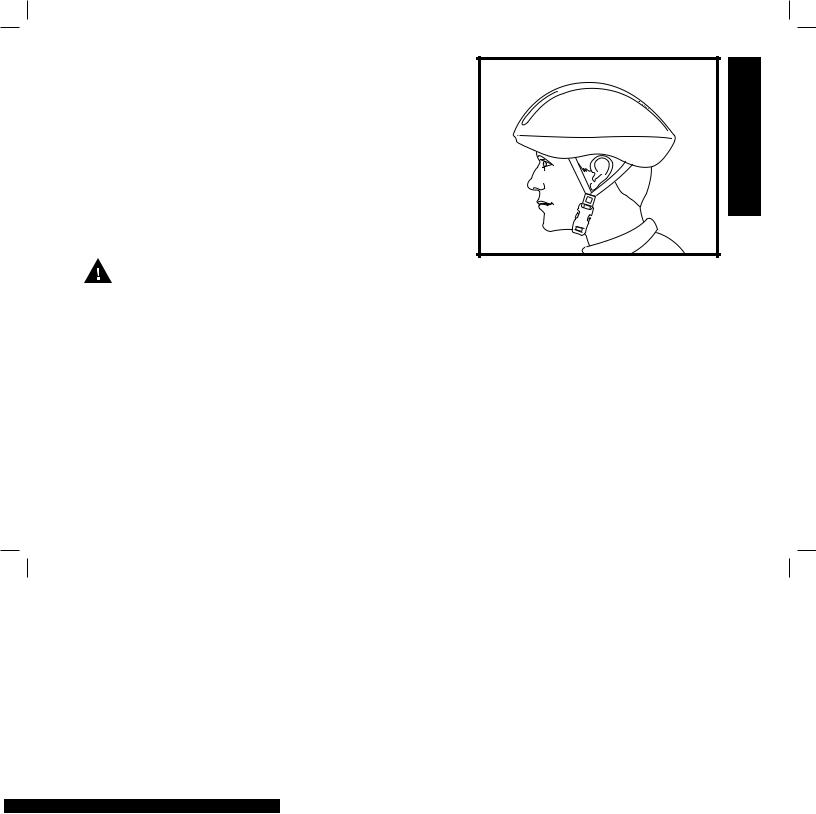
HELMETS
Local laws of most places require a helmet, and common sense requires them in other places where it is not the law. It is strongly advised that a properly fitting, CSPC approved, bicycle safety helmet be worn at all times when riding your bicycle. In addition, if you are carrying a passenger in a child safety seat, they must also be wearing a properly fitted helmet.
The correct helmet should:
•be comfortable
•be lightweight
• have good ventilation
• fit correctly
WARNING
Always wear a properly fitted helmet when riding a bicycle. Falling off your bicycle without a helmet can cause serious injury or death. Many states require specific safety devices. It is your responsibility to familiarize yourself with the laws of the state where you ride and comply with all applicable laws, including properly equipping yourself and your bike as the law requires. Reflectors are important safety devices which are designed as an integral part of your bicycle. Federal regulations require most types of bicycles to be equipped with front, rear, wheel, and pedal reflectors. These reflectors are designed to pick up and reflect street lights and car lights in a way that helps you to be seen and recognized as a moving bicyclist. Check reflectors and their mounting brackets regularly to make sure they are clean, straight, unbroken, and securely mounted. Replace damaged reflectors and straighten or tighten any that are bent or loose.
REFLECTORS
Your bicycle is supplied with one front (white), one rear (red), two wheel (white), and two pedal (orange) reflec - tors. These are an important safety and legal requirement, and should remain securely fitted and in good, clean conditions at all times. Periodically, inspect all reflectors, brackets, and mounting hardware for signs of wear or damage. Replace immediately if damage is found. Some bicycles will require you to install your reflectors onto your bicycle.
RIDE YOU BEFORE
BEFORE YOU RIDE | 18

BEFORE YOU RIDE
Please refer to the following section for instructions on all types of bicycle reflectors.
NOTE: CPSC Regulations do not require reflectors on 10”, 12” and 16” Sidewalk Bicycles - We recommend, however, that you attach reflectors for the protection of the rider. These types of bicycles should be operated during daylight hours only, on a smooth, paved surface such as a sidewalk, under the direct supervision of an adult. These bicycles should never be ridden in the street, on an incline, or on rough terrain. Under no circumstances should these types of bicycles be operated at speeds that would make it difficult to control, nor should it be raced or used for stunting, jumping, motocross, or off-road use or other activities not normally associated with a Sidewalk Bicycle.
FRONT MOUNT REFLECTOR BRACKET ASSEMBLY
Slide reflector over bracket as shown in diagram and ensure that the tab clicks into the top hole of the bracket. Insert one washer onto the hex bolt and insert hex bolt through the reflector bracket and then through the fork. Next, insert a second washer onto the bolt and thread a hex nut onto the bolt behind the fork. Tighten bolts until snug, making sure the reflector is in an upright position.
WHEEL REFLECTORS
The wheel reflectors should come already attached to the spokes of both the front and rear wheels. To attach reflector to the wheel, fit the groove in the reflector to a spoke that matches the groove. The reflector should be mounted across from the valve stem and as close to the rim as possible. The reflector should fit firmly between a single spoke on one side and two spokes on the other. Use the supplied clip (with two locking prongs), fit the clip over the spoke and into the hole and press until the locking prongs “click” into place. Be sure to fit reflectors to both wheels.
19 | BEFORE YOU RIDE
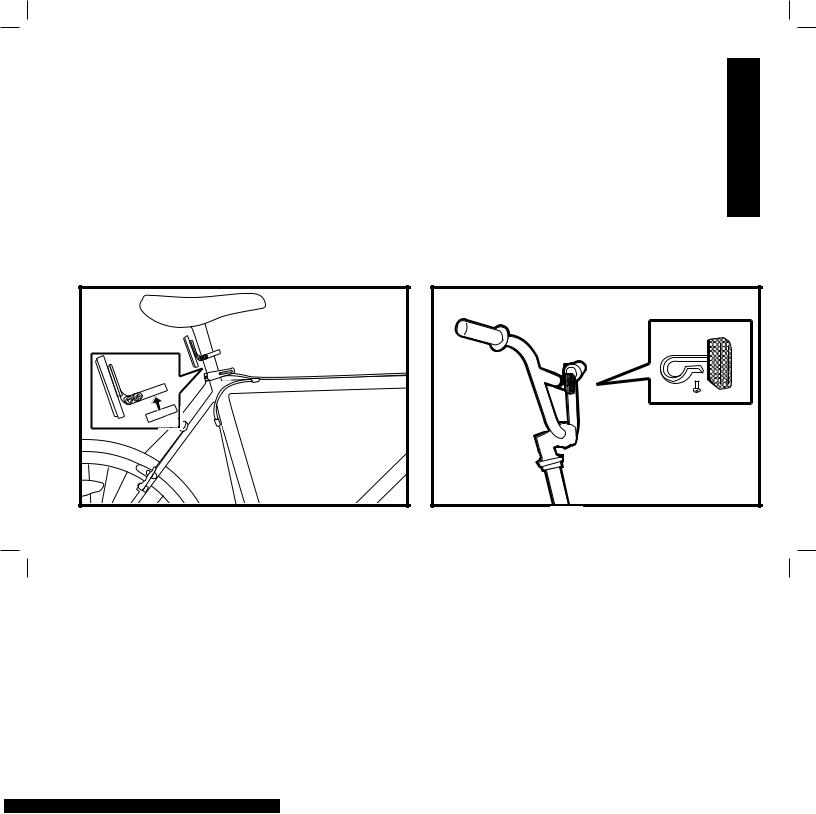
SEAT AND HANDLEBAR MOUNTING REFLECTORS
Slide reflector over bracket (shown on page 19) and ensure that the tab clicks into the top hole of the bracket. Next, remove the clamp screw and open the clamping reflector bracket. Place clamping reflector bracket around the handlebar or seatpost. If the clamp is too loose, insert the shim inside of the clamp. Tighten the clamp screw to hold reflector assembly in place. Finally, adjust the reflector such that it is upright and facing away from the bike.
SEATPOST MOUNT REFLECTOR BRACKET ASSEMBLY
Slide reflector over bracket as shown in diagram below and ensure that the tab clicks into the top hole of the bracket. Insert one washer onto the hex bolt and insert hex bolt through the reflector bracket and around the seatpost. Tighten bolts until snug, making sure the reflector is in an upright position. See diagram below.
PEDAL REFLECTORS
Pedal reflectors are requiredby federal law. Maintain them and replace any that are missing.
RIDE YOU BEFORE
BEFORE YOU RIDE | |
20 |
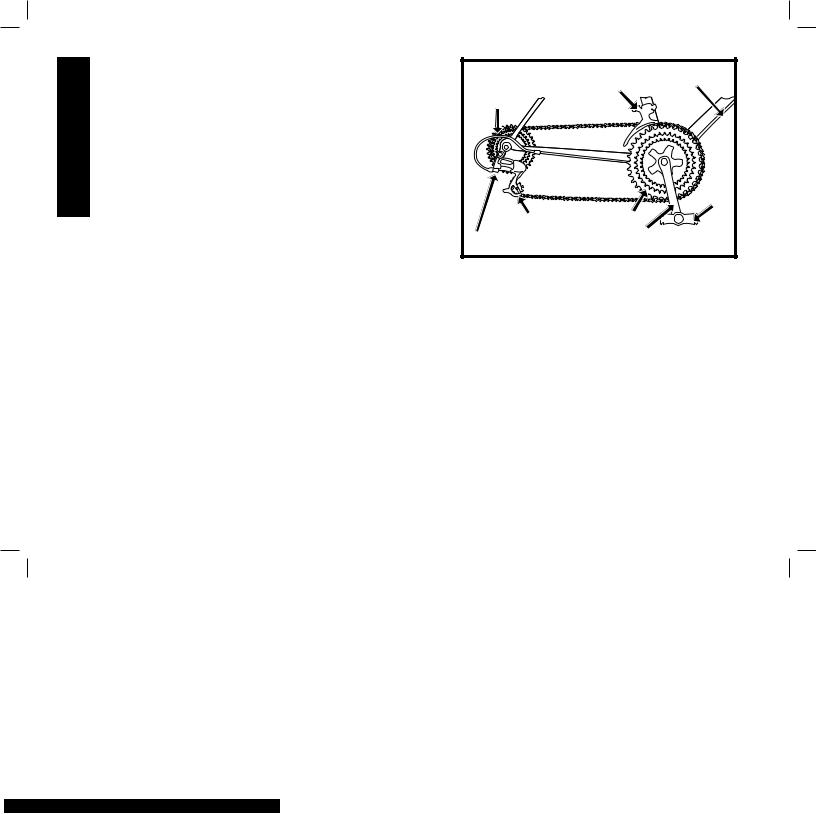
RIDE |
GEARS - HOW TO OPERATE |
|
Derailleur Gears |
||
|
||
YOU |
Most multi-speed bicycles today are equipped with what |
|
are known as derailleur gears. They operate using a system |
||
|
of levers and mechanisms to move the drive chain between |
|
BEFORE |
different sized driving gears or cogs. The purpose of gears |
|
is to let you maintain a constant, steady pedaling pace |
||
|
under varying conditions. This means your riding will be |
|
|
less tiring without unnecessary straining up hills or fast |
|
|
pedaling down hill. Bicycles come with a variety of gear |
|
|
configurations from 5 to 27 speeds. A 5-6 speed bicycle |
|
|
will have a single front chain-wheel, a rear derailleur, and |
|
|
5 or 6 cogs on the rear hub. Bicycles with more gears will |
|
|
also have a front derailleur, a front chainwheel with 2-3 |
|
|
cogs, and up to 7 cogs on the rear hub. |
|
|
Operating Principles |
|
|
No matter how many gears, the operating principles are |
|
|
the same. The front derailleur is operated by the left shift |
|
|
lever and the rear derailleur by the right. To operate, you |
|
|
must be pedaling forward. You can not shift derailleur |
|
|
gears when you are stopped or when pedaling backwards. |
|
|
Before shifting, ease up on your pedaling pressure. For |
|
|
a smooth gear change when approaching a hill, shift to a |
|
|
lower gear BEFORE your pedaling speed slow down too |
|
|
much. When coming to a stop, shift to a lower gear first so |
|
|
it will be easier when you start riding again. If, after |
|
|
selecting a new gear position, you hear a slight rubbing |
|
|
noise from the front or rear gears, gently adjust the |
|
|
appropriate shifter using the barrel adjusters until the noise |
|
|
goes away. For optimal performance and extended chain |
|
|
life, it is recommended that you avoid using the extreme |
|
|
combinations of gear positions (diagram page 22) for |
|
|
extended periods. |
21 | BEFORE YOU RIDE
DRIVE TRAIN |
|
Derailleur |
|
Front Derailleur |
Control Cable |
|
|
|
Freewheel Cogs |
|
|
Pedal
Guide Pulley |
Front Chainwheels |
Rear Derailleur |
Crank Arm |
|
 CAUTION
CAUTION
Children under age 9 should only ride single speed bicycles as they do not have capability to use shifters.
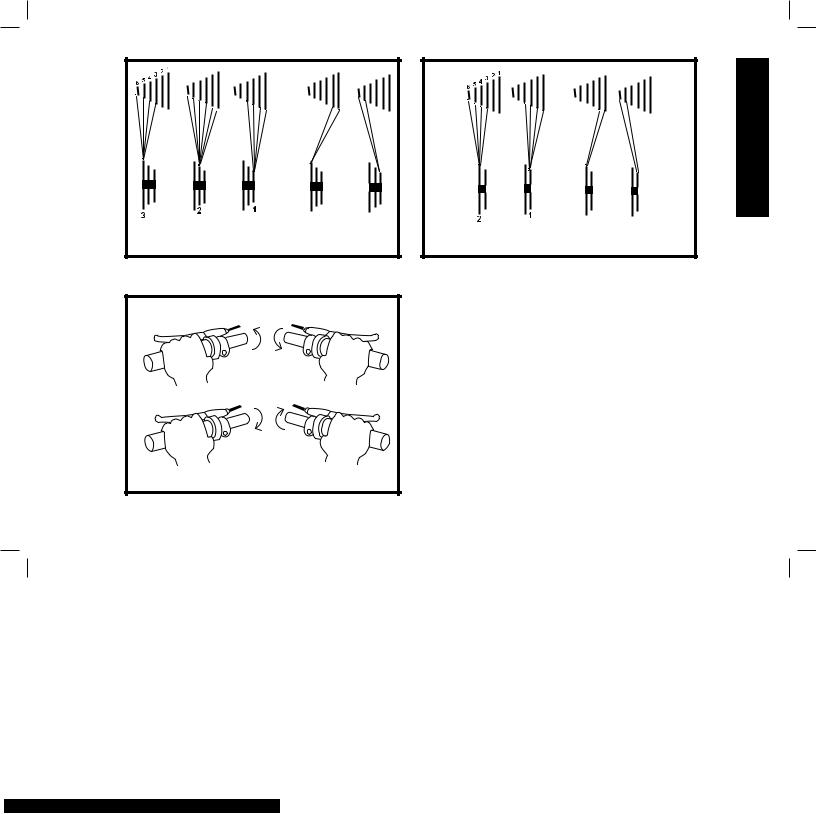
RIDE YOU BEFORE
High |
Middle |
Low |
For optimal performance, |
High |
Low |
For optimal performance, |
|
|
|
NOT RECOMMENDED |
|
|
NOT RECOMMENDED |
Recommended Chainwheel/Rear Sprocket Gear Combinations
Front Low Gear |
Rear Low Gear |
Front High Gear |
Rear High Gear |
Hand Grip Shifters
Many bicycles are now being equipped with a shifting mechanism that is built into the handlebar grips and does not make use of separate levers. The shifting is built into the inside part of the grip that allows the thumb and index finger around. To select a lower gear, twist the grip-to wards you to engage a larger rear cog. You can shift one gear at a time by moving the shifter one click, or through multiple gears by continuing twisting. By twisting the left shifter forward or away from you, a smaller chainwheel can be selected. To select a higher gear, twist the right shifter forward or away from you to engage a smaller rear cog. To engage a larger front chainwheel, twist the left shifter towards you.
NOTE: Some bicycles may be equipped with a rear derailleur mechanism that works in reverse to the direction above.
BEFORE YOU RIDE | 22
